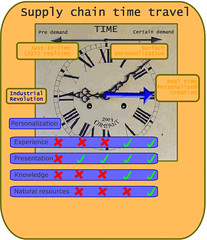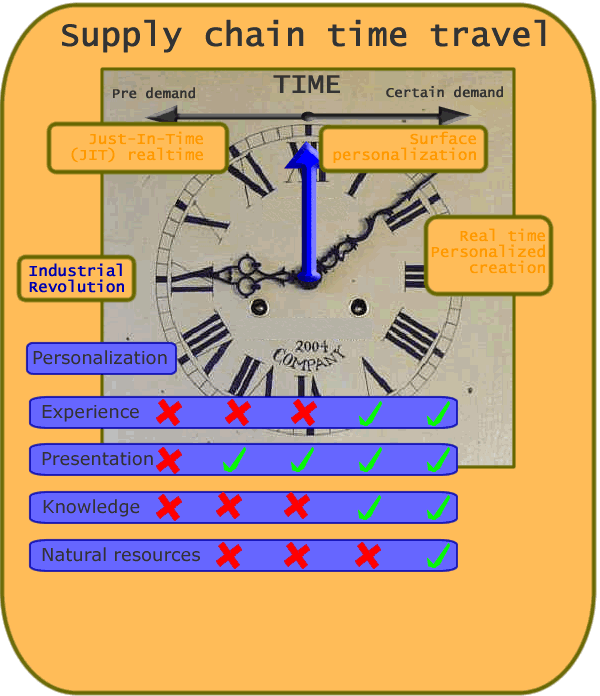Thursday, April 05, 2007
The way the economy will be
I want to purchase a car powered by 'black light power'.
This car does not exist today so I will need to fund the entire project. Here is how I will do it.
1. I use the Internet to tell the story about the car I want to drive, I input all my personal information and express my design of the car as compete as best I can ( luckily for me get tools are provided online, almost nil time and its fun and easy). I am 100% certain I will buy the car in 24 months time and use a marketplace to guarantee the purchase price of $80,000.
Two, challenges, I can not build the car, $80,000 is not enough to create the new car.
I go to the Internet again. Here, I find a pool of knowledge workers capable of creating the car, the marketplace tells me that the knowledge worker cost to create the car is $12,000,000.
I can not afford that but luckily, the word has got out on the de-centralised social network and 200 other people have join my 'black light power' car. And 19 others have committed $80,000. The cash is 100% committed now, now we have $1,600,000 (80k * 20) committed to creating the car.
A new attention economy outlook hedge fund has been analysing the Internet marketplaces. It notes that 201 * $80k $16,080,000 of potential income for the market (they note only 10% of that income is guaranteed) but on the upside they reckon more than 200 people in the world will want to purchase a personalised 'black light powered' car.
So, they go to the marketplace and pledge, $10,400,000 to the group of knowledge workers. The projects contracts are signed and to the total of $12m (10.4m investment + customer guaranteed $1.6m)
I and my fellow customers, guaranteed buyers, plus those not guaranteed plus new people that keep hearing about the project provide continues feedback, the same goes for the knowledge workers. Technical and design milestones are hit and the car is delivered in 24 months.
Return on investment for Hedge Fund. I was thinking you will pay them? Customers, knowledge workers, further users of the 'knowledge'.
OK, they invested $10.4m Where and how do they get a return?
Lets assume it is from the knowledge workers as they receive the cash for customer sales, in the context of they will need paid from the investors cash pre the sale of the first car from those not committed to pay up front.
So, in effect the non-committed future customer buying cars provide the new cash flows. Lets assume some sales,
200 expressed interest, 20 pre paid up front ( so they should get a return in the same way as the investors, thus reducing the cost of their product, this a positive incentive to pre pay, this does not exist in today's economy.)
We have 190 customer that see the completed car and want to purchase @ $80,000 Total sales $15,200,000.
The return for the investor (there percentage of income) 87% of $15.2 = $13.2m Profit ($13.2-10.4) $2.8m 27% return over 24 months plus the upside.
Lets assume 2000 new orders come in return 87% of $150.2 = £130m Profit ($130-10.4) 120m 1152%
So, the maths seem to stack up. I would envision that compared to building a car today, in the future the development cost per car will become less as we get more and more personalization coming into the market. Thus smaller absolute number of customers pooling together will be required to stimulate demand for new products.
Tuesday, April 03, 2007
Life Capitalism - Future looking supply chains
Businesses and eventually all businesses will be able to deliver products in speeds reaching real time. However, this does not guarantee profits, probably quiet the opposite. The new incentive will be to eliminate or manage this risk. Future looking supply chains will be the tool. Ironically, the success of this economy will not be gained by the supply chain. It will be from its complementary partner in Monetary Capitalism, the Demand Chain. I never thought thinking of two chains was particularly useful and if we continue to think in those terms a lack of profits will flow your way. Demand, what is demand? An individuals, groups of individuals that want to do or consume some thing right now in the world or plan to do that in some point in the future, a second from now to days, weeks or even years ahead.
This demand sets up future looking supply chains, demand will be used as the currency to use Personalization In Time (PIT) tools that maximise those businesses servicing demand. The better you do this the higher the profits and the lower the risk of manufacturing, whether that be information, products, services or thoughts.

supplychaintimetravel3
Originally uploaded by ecotorch.
Approaching High Noon for Monetary Capitalism Supply chains JIT
In terms of supply chain management the economic model of the industrialisation era has brought us COMMODITY supply chains that are approaching real time. Real time in the sense that Just In Time techniques (JIT) have squeezed the natural realities of material good and service manufacture to their limit. Even if businesses reach this point this does not guarantee success or profits. It is probably more likely that a business reaching this point will be making losses, unless it has guessed what to make. As this is all happening really fast, so fast that years of profitable history and a balance sheet cash rich can be broken. This will become too risky for a business. They will seek a new model of stability. Future looking supply chains will be the path to pursue.

supplychaintimetravel2
Originally uploaded by ecotorch.
